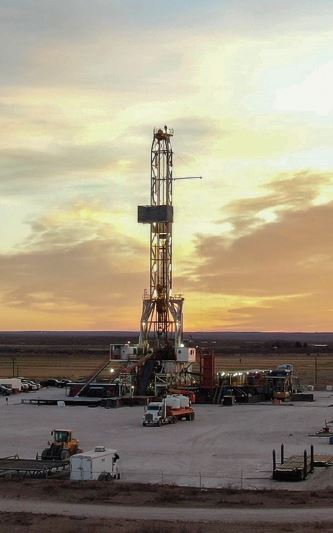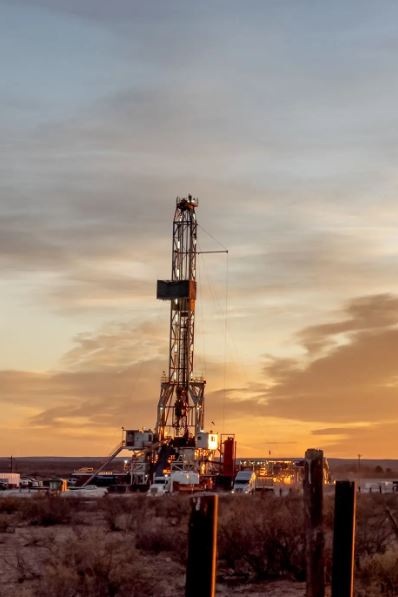Geographically, the New Mexico side of the Permian Basin seems small—only five of the region’s 54 counties are there. But those five—mainly Lea and Eddy—account for 29 percent of the Basin’s total production, according to figures from the U.S. Energy Information Administration (EIA). Lea and Eddy rank second and third in the Permian as well as in the entire United States in oil production.
 Its Permian counties account for 95 percent of New Mexico’s total production, with the rest coming from the San Juan Basin on the complete opposite side of the state. The San Juan is mainly known for its natural gas output, accounting for 67 percent of the state’s production of that hydrocarbon.
Its Permian counties account for 95 percent of New Mexico’s total production, with the rest coming from the San Juan Basin on the complete opposite side of the state. The San Juan is mainly known for its natural gas output, accounting for 67 percent of the state’s production of that hydrocarbon.
Mostly because of its Permian connection, the state is also second in oil production in the United States, trailing only Texas on that score. Mineralanswers.com reports that between 1973 and January of 2025, 116,888 oil and gas wells had been drilled in the state to arrive at that production.
In a December 2024 report, the Dallas Federal Reserve noted that the oil and gas industry contributed 4.2 percent to New Mexico’s GDP in 2023, the last year for which it has figures. It was also a major contributor to the state’s budget. “Direct collections from oil and gas made up 20 percent of the state’s revenue for the general fund during the recent period and are expected to increase to 23 percent by fiscal 2025. The combination of direct and indirect collections from oil and gas brought contributions to the general fund to 35 percent in fiscal 2023,” said the report.

Mike Miller
When including the state income tax from oil and gas employment, the total percentage approaches 50 percent of the state’s income, said Mike Miller, the PBPA’s government relations liaison for New Mexico. Some organizations estimate direct industry employment at 100,000 people, with others involved indirectly in construction and other related industries.
And of the top oil producing states, only New Mexico and Texas saw total oil production increase between 2019 and 2023, with the former’s production almost doubling (up 97.8 percent), as can be seen at this link: tinyurl.com/yx42sh94. It’s a much higher percentage increase than that of second place Texas’s 7.9 percent.
Beyond just the percentage, the state’s absolute total barrels increased by more than any other, says the Fed. “On an absolute basis, annual oil production increased 0.9 million barrels per day in New Mexico, compared with a rise of 0.4 million barrels per day in Texas. Overall oil and gas output in Texas is about three times that of New Mexico,” said the Fed. Oil output in all other producing states decreased over that period.
Despite its statewide contributions, however, political sentiment against the industry is widespread, as a supermajority of legislators are what might be categorized as progressives, being sold on the philosophy that fossil fuels are responsible for global warming. That sentiment often translates to higher taxes and tighter regulations than are found in other states—and the contrast between New Mexico and its cross-border Permian Basin neighbor are significant.
In fact, said Miller, with the Trump administration working to reduce rules the industry considers onerous, and the Republican-led Congress passing legislation instruction to the EPA to relax the methane capture tax laws, many in Santa Fe are therefore working to “Trump-proof” the state by passing their own tighter restrictions and bypass the changes in federal laws.
One way to move toward that goal would be to become the fourth state to have “primacy” over the EPA in regulatory matters. The main purpose of primacy in the past has been to avoid the EPA’s backlog in permitting Class VI wells for carbon capture and storage (CCS) and other regulations under the Safe Drinking Water Act. Primacy is allowed as long as state regulations match or exceed EPA rules—which is exactly New Mexico’s goal, Miller asserted. But being granted primacy involves a lengthy federal review process, and a Trump-led EPA might be less amenable to handing the reins to a state wanting to flip a “Trump-proofing” switch.
Some progressive legislators had opined to Miller that keeping the regulatory bar set high and extracting greater revenue from the industry might actually help the oil companies by assuaging some concerns of the more extreme environmentalists. Those measures then might cause the green movement purveyors to back off. But Miller expressed doubt that the far left could ever be satisfied by anything short of the industry’s complete demise. The “Keep It in The Ground” movement comes to mind.

Stephen Robertson
Not only sentiment, but land ownership is also different, as Texas is among the few states west of the Mississippi where most land is privately held. Said PBPA Executive Vice President Stephen M. Robertson, “Acreage in southeast New Mexico is a checkerboard of private, state, and federal lands. You really can’t develop one type of land without having to deal with the owners of the other types of land.”
As Robertson explained, the prevalence of federal land gives some government leaders the idea that “the development of oil and gas is the extraction of ‘the people’s’ resources. Due to that mindset, operators in New Mexico have to deal with a different regulatory regime in the state compared to Texas. It is a regulatory institution that does not seem to trust business of any sort.”
The large percentage of government land leads state officials to argue that oil and gas are “the people’s resources,” Robertson said, even when it comes from privately-owned land, which is some of the thinking behind the tighter regulations.
 This thinking has also led legislators to look into further taxing an industry that already funds a significant part of the state’s budget. One bill, which Republicans and industry groups have nicknamed the Piñata bill, was described by a Permian Basin legislator as follows, according to Miller. “You just hit it with the stick and candy falls out of it. You go back and you hit it again, and a little more candy comes out and you hit it again, and maybe a little more candy comes out and you hit it again and guess what? No more candy,” indicating the belief that the state could tax the oil and gas industry out of existence.
This thinking has also led legislators to look into further taxing an industry that already funds a significant part of the state’s budget. One bill, which Republicans and industry groups have nicknamed the Piñata bill, was described by a Permian Basin legislator as follows, according to Miller. “You just hit it with the stick and candy falls out of it. You go back and you hit it again, and a little more candy comes out and you hit it again, and maybe a little more candy comes out and you hit it again and guess what? No more candy,” indicating the belief that the state could tax the oil and gas industry out of existence.
But Robertson sees any ideas of a mass migration across state lines as being fraught with its own challenges. “Companies aren’t just thinking about leaving New Mexico for operations in Texas, they have been making this decision for years. The difficulty, of course, is that even with the multiple geologic benches that can be produced in the Permian Basin, when more operators are chasing the opportunity to develop those assets in Texas, that will drive up the cost of development and eventually even those operations could become uneconomical.”
The Good News
Despite the aforementioned headwinds, the nation’s second-leading oil and gas producer has practically doubled production since 2019, and as of this writing, New Mexico drilling rigs were at 111, up by five over the previous week and by three over the same period in 2024. That compares with 290 in Texas, down 86 from the previous year, and 621 nationally, down 134 from a year ago. Its rig growth sets it apart from the national trend.
Robertson and Miller both declared that the state’s Permian counties have lots of “great rock” and many prime drilling locations remaining. Robertson noted the irony of the fact that industry proponents may have made a “mistake” in pointing out the industry’s rich reserves, because it may have then made them think the piñata’s supplies were endless.

Paul Wiseman
A longtime contributor to PB Oil and Gas Magazine, Paul Wiseman is an energy industry freelance writer. His email address is [email protected].
The post New Mexico: Taking Stock appeared first on Permian Basin Oil and Gas Magazine.






















